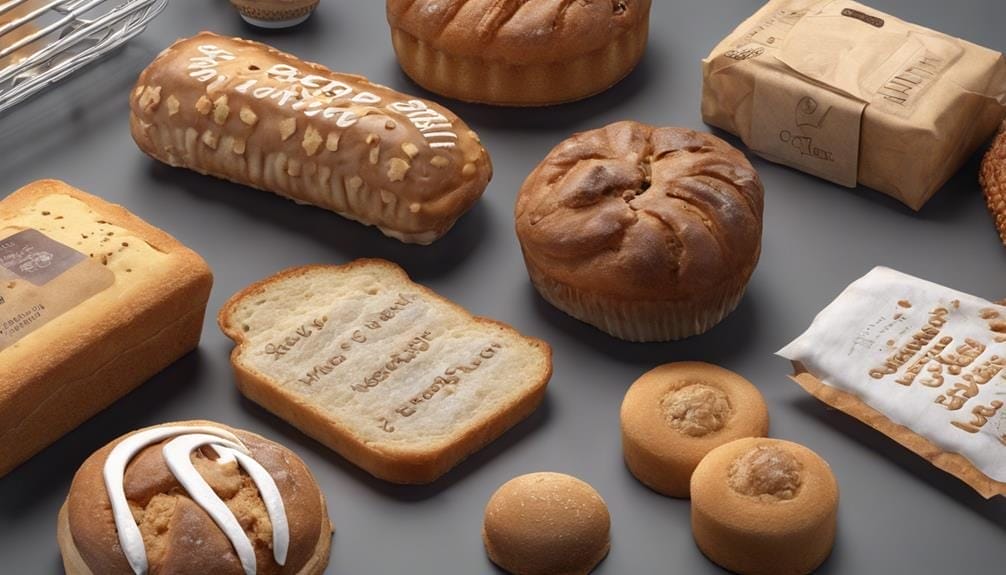When pricing your home-baked goods, factor in ingredients cost, utilities, and packaging. Calculate the price per unit based on portions and desired profit margin. Consider market prices for similar items to stay competitive. Don't forget to include labor costs to guarantee fair compensation. To estimate accurately, keep detailed records and adjust prices accordingly. Recognize the value of your time and effort in setting prices. Mastering these aspects will help you price your baked goods effectively.
Importance of Ingredient Labels
Ingredient labels play an important role in informing customers about the contents of baked goods they consume. When it pertains to labeling your baked goods, ensuring accuracy and transparency in your ingredient list is vital. Not only does this help individuals with allergies make informed choices, but it also showcases your dedication to compliance with food safety regulations.
By providing clear and detailed ingredient labels, you not only improve the credibility of your brand but also cultivate trust with your customers. Customers value transparency, particularly regarding the food they consume. This openness can lead to increased brand loyalty and a positive reputation for your baked goods.
Legal Requirements for Labels
To adhere to legal regulations, make sure that your labels for baked goods include not only the list of ingredients but also the business name, address, and production details.
When creating labels for your baked goods, ensure you meet the following legal requirements:
- Cottage food labeling: If you're selling homemade baked goods as a cottage food business, your labels must comply with state regulations to guarantee they're clear and accurate.
- Allergen warnings: It's important to include allergen warnings on your ingredient labels, especially for major food allergens, to inform customers and comply with legal standards.
- Nutritional information: Providing nutritional information such as calorie content on your labels may be necessary, helping consumers make informed choices about your baked goods.
Common Allergens to Highlight

Highlighting common allergens on baked goods labels is vital for guaranteeing consumer safety and transparency in food products. Common allergens such as milk, eggs, wheat, soy, peanuts, tree nuts, fish, and shellfish must be clearly identified on ingredient labels to assist individuals with food allergies in making informed choices.
By prominently listing these allergens, baked goods labels can help prevent allergic reactions and promote food safety as a whole. It isn't only a good practice but also a legal requirement to accurately label allergens to protect consumers and uphold transparency in food products.
To ensure effectiveness, ingredient labels for baked goods should present allergens in an easily readable format for quick identification by consumers. By highlighting these common allergens on labels, bakers can contribute to a safer and more transparent food environment, providing vital information for those with food allergies.
Impact on Consumer Purchasing Decisions
Clear and accurate ingredient labels on baked goods greatly impact consumer purchasing decisions. When a bakery provides detailed product labels, it influences buyers significantly. Here's why:
- Transparency Builds Trust: Consumers appreciate transparency in ingredient labels as it shows the bakery's commitment to honesty and quality.
- Allergen Information is Essential: Including allergen information helps customers with food allergies make informed choices, leading to increased trust and loyalty.
- Perceived Quality and Safety: Baked goods with detailed ingredient labels are perceived as higher quality and safer for consumption. This perception can positively influence consumer decisions.
Tips for Reading Labels

When examining ingredient labels on baked goods, start by looking at the ingredient list to understand what components are used in the product. This list will help you identify any common allergens such as nuts, dairy, or gluten, especially if you have dietary restrictions.
Keep in mind that ingredients are listed by weight, so the ones at the beginning have higher quantities in the product. Be on the lookout for any additives or preservatives, as they can affect the nutritional value of the baked goods.
By understanding these labels, you can make informed choices about the products you consume, ensuring they align with your health goals and preferences. Reading labels may seem overwhelming at the outset, but with practice, you'll quickly become adept at deciphering them and making conscious decisions about the baked goods you purchase.
Stay vigilant, stay informed, and make choices that support your well-being.
Frequently Asked Questions
How Do I Make a Label for Baked Goods?
To make a label for baked goods, consider design tips, legal requirements, branding strategies, allergen info, font choices, visual hierarchy, and FSC certification. Start by crafting a clear, informative label that reflects your brand.
How Do I Make Ingredient Labels?
To guarantee ingredient labels, meet legal requirements, include nutrition facts, allergen warnings, and storage instructions. Design labels with clear fonts. Dual labels can efficiently provide all necessary information.
What Must Appear on the Label of Bakery Products?
To label bakery products accurately, include nutritional information, allergen warnings, net weight, country of origin, shelf life, serving size, and contact information. This guarantees customer safety and compliance with regulations for transparent product details.
What Are the Requirements for Ingredients Listing?
When listing ingredients, make sure to include allergen information, dietary restrictions, nutritional facts, organic ingredients, preservatives used, flavor boosters, and sweeteners. This informs customers about what they're consuming for safety and dietary purposes.
Conclusion
In summary, understanding and properly reading ingredient labels for baked goods is essential for both your health and safety.
By being aware of common allergens, legal requirements, and the impact on consumer choices, you can make informed decisions about the products you consume.
Remember to always check labels carefully and choose products that align with your dietary needs and preferences.
Stay informed and stay safe in regard to your baked goods choices!